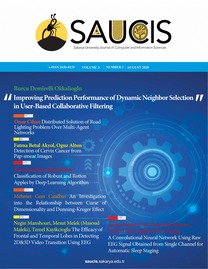Detection of Cervix Cancer from Pap-smear Images
Pap-Smear Görüntülerinden Rahim Ağzı Kanseri Tespiti
___
[1] "National Institutes of Health homepage", 2020. [Online]. Available: https://www.cancer.gov/about-cancer/understanding/what-is-cancer). [Accessed: 01-Feb-2020].[2] Cancer Today, "Global Cancer Observatory homepage", 2018. [Online]. Available: http://gco.iarc.fr/today/online-analysis-table. [Accessed: 02-Feb-2020].
[3] DB. Cooper, C.E. McCathran, "Cervical Dysplasia", StatPearls [Internet]. StatPearls Publishing, 2019.
[4] RJ. Kurman, D. Solomon, The Bethesda System for Reporting Cervical/Vaginal Cytologic Diagnoses. New York: Springer-Verlag, 1994.
[5] S.E. Waggoner, "Cervical cancer", The Lancet, vol. 361, no. 9376, pp. 2217-2225, 2003.
[6] T. Bilal, J. Dias, and N. Werghi, "Classification of cervical-cancer using pap-smear images: a convolutional neural network approach", Annual Conference on Medical Image Understanding and Analysis, Springer, Cham, 2017.
[7] M.E. Plissiti, N. Christophoros, and A. Charchanti, "Automated detection of cell nuclei in pap smear images using morphological reconstruction and clustering", IEEE Transactions on information technology in biomedicine, vol. 15, no.2, pp. 233-241, 2010.
[8] P. Wang, L. Wang, Y. Li, Q. Song, S. Lv, X. Hu, “Automatic cell nuclei segmentation and classification of cervical Pap smear images”, Biomedical Signal Processing and Control, vol. 48, pp. 93-103, 2019.
[9] Y. Marinakis, G. Dounias, and J. Jantzen, "Pap smear diagnosis using a hybrid intelligent scheme focusing on genetic algorithm based feature selection and nearest neighbor classification", Computers in Biology and Medicine, vol. 39, no.1, pp. 69-78, 2009.
[10] A. GençTav, S. Aksoy, and S. Önder, "Unsupervised segmentation and classification of cervical cell images", Pattern recognition, vol. 45, no.12, pp. 4151-4168, 2012.
[11] H.A. Phoulady, "A framework for nucleus and overlapping cytoplasm segmentation in cervical cytology extended depth of field and volume images", Computerized Medical Imaging and Graphics, vol. 59, pp. 38-49, 2017.
[12] K.P. Win, Y. Kitjaidure, K. Hamamoto, T. Myo Aung,"Computer-Assisted Screening for Cervical Cancer Using Digital Image Processing of Pap Smear Images", Appl. Sci., vol. 10, no.5, pp.1800, 2020.
[13] W. William, A. Ware, A.H. Basaza-Ejiri, & J. Obungoloch, "A pap-smear analysis tool (PAT) for detection of cervical cancer from pap-smear images", Biomedical engineering online, vol.18, no.1, pp.16, 2019.
[14] V. Vapnik, The nature of statistical learning theory. New York: Springer-Verlag, 1995.
[15] M. Pal, "Random forest classifier for remote sensing classification", International Journal of Remote Sensing, vol.26, no.1, pp. 217-222, 2005.
[16] M.W. Gardner, S.R. Dorling, "Artificial neural networks (the multilayer perceptron) —a review of applications in the atmospheric sciences", Atmospheric Environment, vol. 32, no. 14–15, pp. 2627- 2636,1998.
[17] Y. Liao, V. R. Vemuri, "Use of k-nearest neighbor classifier for intrusion detection", Computers & security, vol. 21, no.5, pp. 439-448, 2002.
[18] M. M. Saritas, A. Yasar, "Performance Analysis of ANN and Naive Bayes Classification Algorithm for Data Classification", International Journal of Intelligent Systems and Applications in Engineering, vol. 7, no. 2, pp. 88-91, 2019.
[19] S.K. Shevade, S. S. Keerthi, "A simple and efficient algorithm for gene selection using sparse logistic regression", Bioinformatics, vol. 19, no. 17, pp. 2246-2253, 2003.
[20] MDE-lab, "MDE-lab downloadspage,"2011.[Online]. Available: http://mdelab.aegean.gr/downloads. [Accessed: 30-Sep-2019].
[21] J. Jantzen, J. Norup, Jonas, G. Dounias, B. Bjerregaard, "Pap-smear Benchmark Data For Pattern Classification", Nature Inspired Smart Information Systems (NiSIS), pp. 1-9, 2005.
[22] N. Nill, “A visual model weighted cosine transform for image compression and quality assessment”, IEEE Transactions on communications, vol.33, no. 6, pp. 551-557, 1985.
[23] M. E. Plissiti, P. Dimitrakopoulos, G. Sfikas, C. Nikou, O. Krikoni, A. Charchanti, SIPAKMED: A new dataset for feature and image based classification of normal and pathological cervical cells in Pap smear images, IEEE International Conference on Image Processing (ICIP) 2018, Athens, Greece, 7-10 October 2018.
[24] H. Demirel, G. Anbarjafari, "Discrete Wavelet Transform-Based Satellite Image Resolution Enhancement", IEEE Transactions on Geoscience and Remote Sensing, vol. 49, no. 6, pp. 1997-2004, 2011.
[25] H. Demirel, G. Anbarjafari, “Image resolution enhancement by using discrete and stationary wavelet decomposition”, IEEE transactions on image processing, vol. 20, no. 5, pp. 1458-1460, 2010.
[26] E.S. Cibas, B.S. Ducatman, Cytology E-Book: Diagnostic principles and clinical correlates, Elsevier Health Sciences, 2013.
[27] "Eurocytology Cervical Cytology homepage", 2020. [Online]. Available: https://www.eurocytology.eu/en/course/1292. [Accessed: 15-Mar-2020].
[28] T. Chankong, N. Theera-Umpon, & S. Auephanwiriyakul, "Automatic cervical cell segmentation and classification in Pap smears", Computer methods and programs in biomedicine, vol.113, no.2, pp.539-556, 2014.
[29] W. William, A. Ware, A.H. Basaza-Ejiri, & J. Obungoloch, "Cervical cancer classification from Pap-smears using an enhanced fuzzy C-means algorithm", Informatics in Medicine Unlocked, vol.14, pp. 23-33, 2019.
[30] L. Zhang, L. Lu, I. Nogues, R.M. Summers, S. Liu, & J. Yao, “DeepPap: deep convolutional networks for cervical cell classification”, IEEE journal of biomedical and health informatics, vol. 21, no.6, pp. 1633-1643, 2017.
- ISSN: 2636-8129
- Yayın Aralığı: Yılda 3 Sayı
- Başlangıç: 2018
Classification of Robust and Rotten Apples by Deep Learning Algorithm
The Efficacy of Frontal and Temporal Lobes in Detecting 2D&3D Video Transition Using EEG
Negin MANSHOURI, Mesut MELEK, Temel KAYIKCIOGLU
Göksu Zekiye ÖZEN, Rayımbek SULTANOV, YUNUS ÖZEN, Zahide YILMAZ GÜNEŞ
Detection of Cervix Cancer from Pap-smear Images
Improving Prediction Performance of Dynamic Neighbor Selection in User-Based Collaborative Filtering
Distributed Solution of Road Lighting Problem Over Multi-Agent Networks
An Investigation into the Relationship between Curse of Dimensionality and Dunning-Kruger Effect
